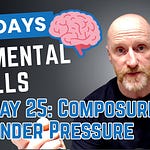The PETTLEP model of mental rehearsal is a comprehensive framework that enhances the effectiveness of focused and purposeful imagination. The practice of Mental Imagery (MI) is used to enhance performance across various fields and domains of work, including medicine and sports and physical activities. This model, developed by Holmes and Collins in the early 2000s, represents the following components:
Physical aspects
Environmental aspects
Task specifics
Timing of tasks
Learning new tasks
Emotional responses
Perspective of performance
The PETTLEP approach is rooted in the idea that the more closely mental rehearsal mimics the actual performance, the more effective it will be in enhancing actual performance. What I am suggesting here is that this idea can be extended beyond the sports performance area and into everyday life experience. Here’s some evidence to support my assertion.
Extensive research has demonstrated an overlap between active brain regions involved in motor imagery (imagining the behaviour) and motor execution (performing the behaviour). Motor imagery is a simulation of physical activity that relies on similar cognitive representations and shares neural networks (Kalicinski et al., 2016)1. Neuroimaging studies have shown an overlap in brain regions (Lotze & Halsband, 2006). Decety et al. (1991)2 found that respiration and heart rate increased during imagined walking. Studies on the real and imagined timing of behaviour have revealed that these are closely aligned (Guillot & Collet, 2005)3. In other words, participants were able to accurately time imagined behaviours with performed behaviours.
“It’s been my dream for as long as I can remember. Every night going to bed, I’d do, I’d slide down the track and go through it, and visualise my dream. But I wouldn’t visualise winning, I’d visualise the process.”
Lizzy Yarnold, Olympic Skeleton Gold Medalist 2014
“What I do, always before a game, always, every night and every day, is try and think up things, imagine plays, which no one else will have thought of, and to do so always bearing in mind the particular strength of each team-mate to whom I am passing the ball. When I construct those plays in my mind I take into account whether one team-mate likes to receive the ball at his feet, or ahead of him; if he is good with his head, and how he prefers to head the ball; if he is stronger on his right or his left foot. That is my job. That is what I do. I imagine the game”.
Former Brazilian footballer, Ronaldinho
“This visualisation technique is a sort of clarified daydream with snippets of the atmosphere from past matches included to enhance the sense of reality. It lasts about twenty minutes, and by the end of it, I feel I know what is coming. The game will throw up many different scenarios, but I am as prepared in my own head for them as I can be. If you have realistically imagined situations, you feel better prepared and less fearful of the unexpected.”
Former England International, Jonny Wilkinson
For this to be possible, Holmes and Collins (2001)4 suggested that the actual performance and the environment should be simulated as accurately as possible. The model is based on the work of Jeannerod (1994, 1997), who proposed that specific brain areas are activated during both physical and imagined movements. They suggest that the best results are achieved when mental imagery is combined with physical practice. The PETTLEP Method consists of the following components.
Physical (P): The physical component emphasises the replication of the physical aspects of the performance during mental rehearsal. This includes not only the basic movements but also finer details, such as body posture, specific muscle movements, and even the replication of physical sensations, including touch and proprioceptive feedback (your ability to sense your own movements). The goal is to engage the same neural pathways that would be used during the actual performance, enhancing the mind-body connection.
Environment (E): For the environment aspect, the individual is encouraged to visualise the specific details of the environment where they will perform. This could include the layout of a sports field, the sounds on the field or in a performance hall, or the lighting in a room. The more vividly you can recreate the environment, the more effective the mental rehearsal will be, as this helps you acclimate to the performance context, reduces anxiety, and enhances focus. In this, we develop familiarity with the space.
Task (T): This element focuses on the specific tasks you are to perform, as well as the detailed and precise mental representations of the required skills or activities. It's about breaking down your performance into its constituent parts and rehearsing each one meticulously. This detailed focus helps refine techniques and correct errors, leading to improved execution during your actual performance or situation.
Timing (T): The timing component emphasises the synchronisation of the mental rehearsal with the real-time duration of the task. This means that if a sprint takes ten seconds to complete, the mental rehearsal of the sprint (or the sales presentation) should also take ten seconds. This aspect is crucial for activities where timing and rhythm are essential, ensuring that the mental practice is as temporally accurate as possible.
Learning (L): The learning aspect acknowledges that as your skills develop and evolve, so too should your mental rehearsal. The imagery should adapt to reflect new strategies, improved techniques, or higher levels of complexity as you progress. This ensures that your mental practice remains challenging and relevant, facilitating ongoing development and mastery.
Emotion (E): Emotional content is implicit in behaviour. For mental rehearsal to be accurate, it must incorporate emotional aspects. This could involve visualising success and the associated positive emotions, as well as preparing for potential stressors or negative emotions and planning strategies to manage them. Emotionally charged imagery can enhance motivation and resilience, contributing to a more robust performance under pressure.
Perspective (P): The perspective from which an individual engages in mental rehearsal can influence its effectiveness. An internal perspective (first-person) can enhance the feeling of control and proprioception, while an external perspective (third-person) can help improve strategy and form. The choice of perspective can be tailored to the specific goals of the mental rehearsal, with some evidence suggesting that a combination of both perspectives may offer the most comprehensive benefits.
Mental Skills Basics Course
Suffering stress and anxiety is not a prerequisite for success in self-employment–there's a better way. Mental skills provide you with the means of coping effectively with difficulty and achieving your goals. I created the Mental Skills Basics Course to introduce business leaders, self-employed individuals, freelancers, consultants, and small business owners to the psychological and emotional skills associated with success.
References
Kalicinski, M., Thomas, M., & Lobinger, B. H. (2016). Motor Imagery and Mental Training in Older Adults. In Performance Psychology (pp. 121-132). Academic Press.
Decety, J., Jeannerod, M., Germain, M., & Pastene, J. (1991). Vegetative response during imagined movement is proportional to mental effort. Behavioural brain research, 42(1), 1-5.
Guillot, A., & Collet, C. (2005). Duration of mentally simulated movement: a review. Journal of Motor Behaviour, 37(1), 10-20.
Holmes, P. S., & Collins, D. J. (2001). The PETTLEP approach to motor imagery: A functional equivalence model for sport psychologists. Journal of Applied Sport Psychology, 13(1), 60-83.










